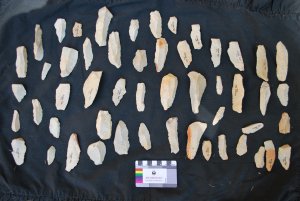By Sam Hedditch- Graduate Diploma of Archaeology student.
I have come to the end of my time with the Winchelsea stone tool collection and I am a little sad to part with it. I have discovered so much about the differences between the tools and raw materials, their uses (of which there are many) and of the history of their collection and research.
The final activities I performed on the collection were taking a complete set of photos for all of the artefacts and some illustrations for a select few. The illustrations were quite tricky in order to get the dimensions and features on the artefacts correct, and it is better to put in less detail than more sometimes (Mumford 1983). The important thing is to be aware of how to display retouch and its direction and to understand that when a jagged line is drawn mistakenly, it may be interpreted as use wear by a reader.
As for the tools, I am unsure of whether they will make it back to where they were taken from because the collector and any records of their collection are gone. I can say that they have being an amazing educational vehicle and have demonstrated to me how adaptable and technological Aboriginal culture is, just through this one aspect. I feel quite confident in identifying stone artefacts in the field in future and would recommend studying stone artefacts for anyone that would like to do the same!

One of the largest bags in the collection, the Coober Pedy Blades.
Mumford, W. 1983 Stone Artefacts: An Illustrator’s Primer. In Graham Connah (ed.), Australian Field Archaeology: A Guide to Techniques. Canberra: Australian Institute of Aboriginal Studies Press.

